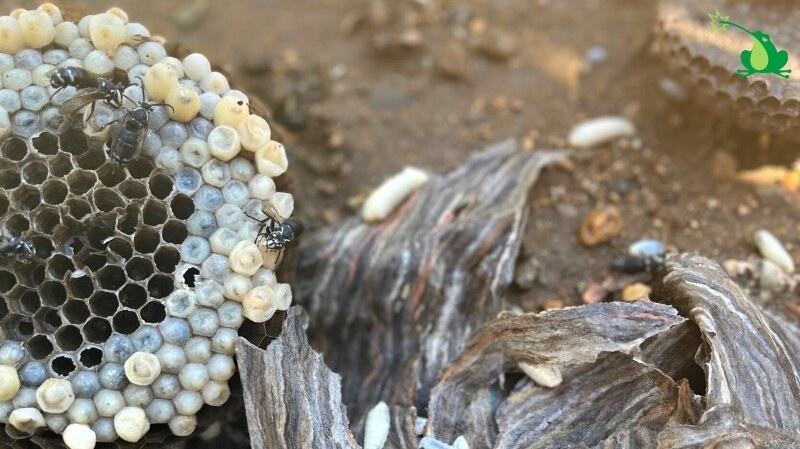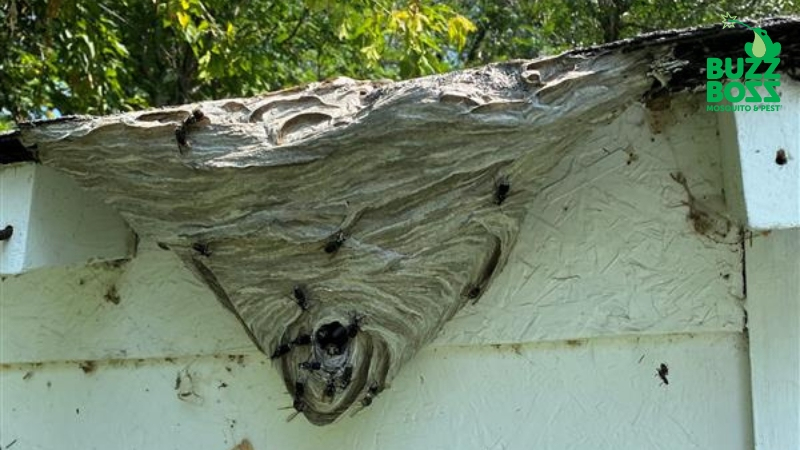Everything You Need to Know About Wasp and Hornet Traps
Reading time: 8 minutesCommon outdoor pests like ants, mosquitoes, and wasps can ruin your time outdoors and potentially even create health hazards for you and your family. The spring, summer, and early fall are a busy time for these buzzers—and they definitely put a damper on your outdoor plans!
Trapping is one good way to manage wasp and hornet populations around your house, but it takes some background knowledge to be able to use traps effectively without harming the local environment. Here’s what to know and how Buzz Boss can help.
$71.39/month




Monthly billing is automatic – it’s easy and convenient.


Know Your Stinger: Differentiating Between Wasps vs. Hornets
Hornets are a type of wasp, and they look quite similar, so it can be difficult to differentiate between the two. Here are some key ways to tell them apart:
WASPS | HORNETS | |
SIZE | Smaller with typically brighter colors | Large and can reach up to 5.5 to 6 cm in length |
COLOR | Usually bright yellow and black rings | Dark brown, red and yellow-orange with black and white rings |
PHYSICAL CHARACTERISTIC | Pointed lower abdomen with a narrow waist | Round abdomens and wide heads |
STING | Mild | Worse Hornet stings tend to hurt more than wasp stings due to the larger diameter and length of their stingers |
NESTS | Small and often exposed | Large, conical, and layered |
AGGRESSIVE | Less | More |
FOOD | Wasps eat insects, but will forage sooner than a hornet will | Prefer to eat insects instead of foraging for food |
Unlike bees, both wasps and hornets have smooth stingers without barbs, allowing them to sting multiple times in a row without stopping.

Types of Wasp and Hornet Traps
Wasp traps work by luring insects inside the trap with some type of bait, where the wasps are either poisoned or trapped in such a way that they cannot escape. There are several types of wasp and hornet traps available, some of which you can even make yourself.
Here’s a look at the most common:
Disposable vs. Reusable Traps
Disposable traps are perhaps the most convenient and are designed to be tossed away once they’re full. Reusable traps, on the other hand, need to be emptied, washed out, refilled, and put out again.
Both disposable and reusable traps are equally effective, so it’s more a matter of personal preference and environmental stewardship. Reusable traps keep plastic and trash out of landfills and prevent animals who are foraging for food from finding the trap and consuming potentially poisonous bait inside.
Jar and Bottle Traps
Bottle traps take advantage of the narrow opening of a bottle to lure wasps in and prevent them from quickly getting back out. The bottom of the bottle is usually filled with a liquid that drowns the wasps, like soapy water. These traps can be made at home from a plastic or glass soda bottle.
Mesh and Water Bag Traps
A mesh bag trap has a durable mesh or netting on the outside of it, which provides an open and airy structure that attracts wasps and hornets but makes it hard for them to escape. Some mesh traps have bait or a glue board, while others just have a funnel that allows insects in but not out.
As for water bags, these aren’t necessarily traps. They’re simply a deterrent that are only marginally effective.
To use this method to discourage wasps from coming around your home, hang plastic zipper bags full of water from doorways, porch ceilings, trees, and other places where wasps are likely to see them. These bags create a reflection when light passes through them; this confuses wasps, steering your property clear of these stingers.
Electric Bug Zappers
Electric bug zappers lure wasps and other flying insects by light and use a high-power UV light to “zap” and kill bugs that come into contact with it. These are a good option for long-term use but can pose a threat to valuable pollinators who may also become attracted to it.
Pheromone and Insecticidal Traps
These traps use commercial pheromones to attract wasps and insecticides to kill wasps once they’re inside the trap. You can purchase traps with both a lure and an insecticide or either one.
How to Keep Your Traps Eco-Friendly
Most wasp and hornet traps pose no threat to the surrounding environment they’re in. However, traps that use insecticides are the least eco-friendly and should be used sparingly and disposed of properly.
Be sure to put your wasp traps out in areas where insects like bees are less likely to find them. You should also make sure that you use a special wasp attractant that won’t appeal to bees.
Best Places to Put Wasp and Hornet Traps
Placing your wasp and hornet traps is about location, location, location.
Where you put them makes a significant difference in the traps’ efficacy and how well they’re able to trap and kill these dangerous flying insects.
They should be at least 6 to 7 meters away from your home and any outdoor areas like porches, garages, pools, and kids’ play equipment. Hang them about four feet from the ground so they can be easily detected by wasps.
Ideally, they should be in quiet, sunny places where there’s a slight breeze that can push the scent around and lure wasps to the trap.

Safety Tips for Trapping Wasps and Hornets
When putting out wasp traps, it’s crucial to take several safety precautions to prevent getting stung:
- Wear thick, long pants and sleeves that cover as much of your skin as possible. Use clothing that’s light-colored to deter wasps and hornets from becoming aggressive. Avoid wearing red or black clothing.
- Shower with plain soap and shampoo. Don't use anything with a fragrance that could attract stinging insects. Specifically, avoid handling bananas or banana-scented soaps, lotions, candies, or other objects.
Wasps, bees, and hornets emit a pheromone when angry that smells like bananas and other sources of the scent could attract aggressive wasps.
- Use plain deodorant without scent. Avoid smelling like sweat, which could also prompt wasps and hornets to attack.
- Avoid going around flowering plants that may have wasps flying around them.
- Keep your yard and the outside of your home clean and decluttered. Wasps and hornets are attracted to discarded food, and other insects that are attracted to the food, like ants and beetles.
- If a wasp is flying nearby, remain composed and calmly get out of the area. Swatting at it will likely cause it to sting. If multiple wasps are flying around you, move quickly. Head indoors, in your car, or into a shaded area.
Don't jump into the water since many wasps and hornets will hover above the surface, waiting to sting when you come up for air.
If you have an allergy to any stinging insects, don't go into any areas where there may be wasps or hornets. Have someone else hang and remove your wasp traps or hire a professional exterminator to address the problem. Have an epi-pen on hand, and consider wearing an allergy alert bracelet.
Frequently Asked Questions (FAQs) About Trapping Wasps and Hornets
How long do wasp traps last?
Most commercial and DIY wasp and hornet traps last between 2 to 4 weeks before they need to be replaced or emptied, washed, and refilled.
Can wasps sense other dead wasps around them?
Wasps produce pheromones when they're angry, feel threatened, hurt, or killed. These scent signals let other wasps know that danger is around. But because of the adversarial nature of these flying insects, they will swarm the threat instead of steering clear.
Is it better to trap or spray wasps?
Wasp spray can be a handy way to take out one or two of these flying stingers, but it’s not a good option for getting rid of wasp and hornet nests. Most likely, you will only kill a few of them and anger the rest. Traps are a more effective and environmentally friendly way to eliminate large numbers of them.
Are bees attracted to wasp and hornet traps?
Bees, which are critical for the ecosystem, can be attracted to wasp traps that use sugary or sweet baits as bait. Instead, use pet food, fish, meat, or decomposing vegetables and fruit to attract these aggressive insectivores. Commercial traps usually contain heptyl butyrate, which appeals to wasps and hornets but not honey bees.
When to Turn to the Pest Control Pros
Any time you’re dealing with potentially hazardous insects, it’s a good idea to consult a pest control professional. This is especially true if you’re allergic and are at serious risk if you get stung.
At Buzz Boss, we use innovative, eco-friendly solutions to trap and remove wasps and hornets from your area and prevent them from coming back. Call us today at 1-844-744-2899 for pest control services.

